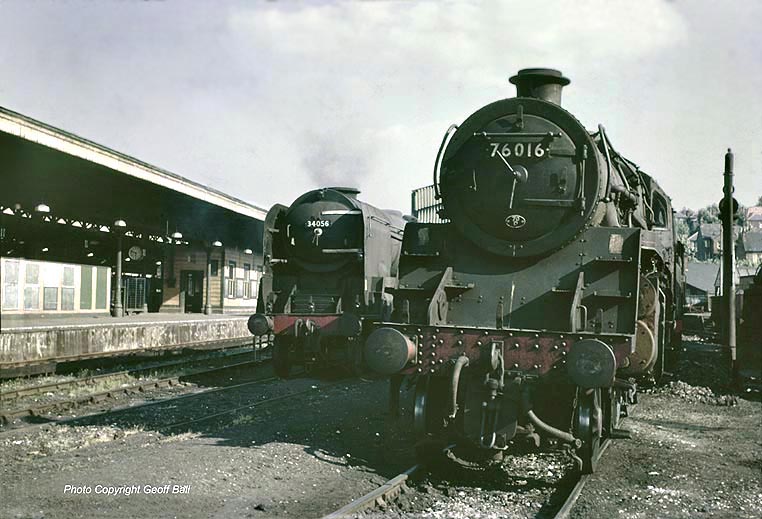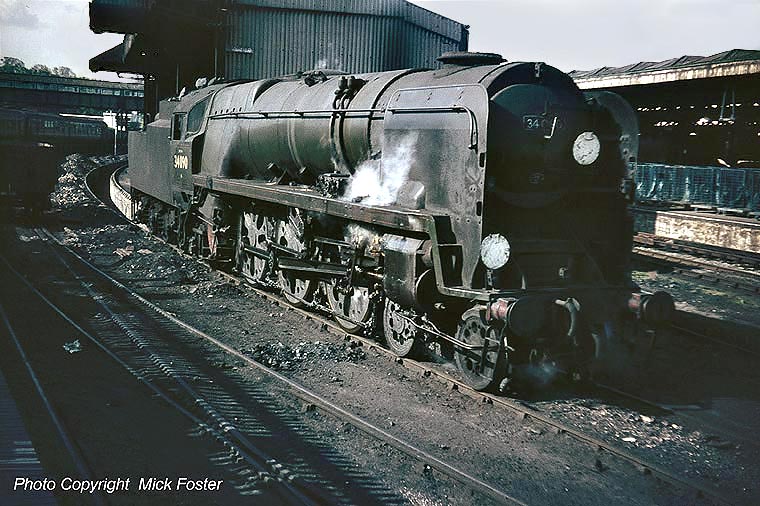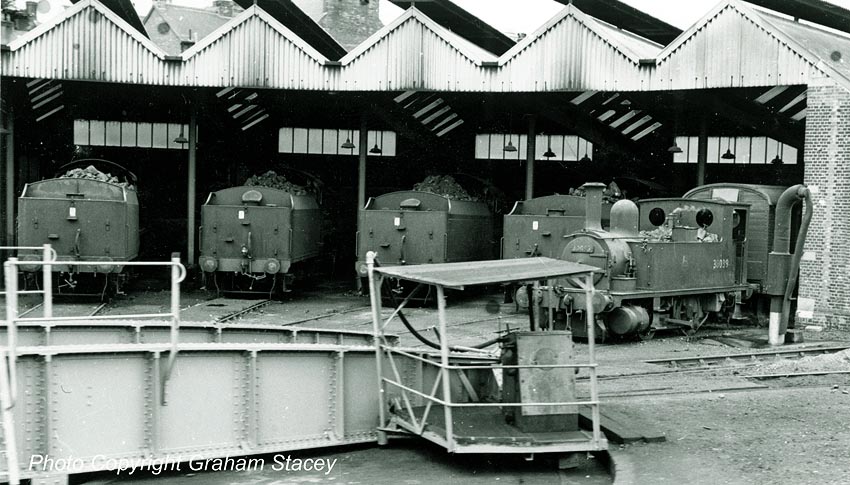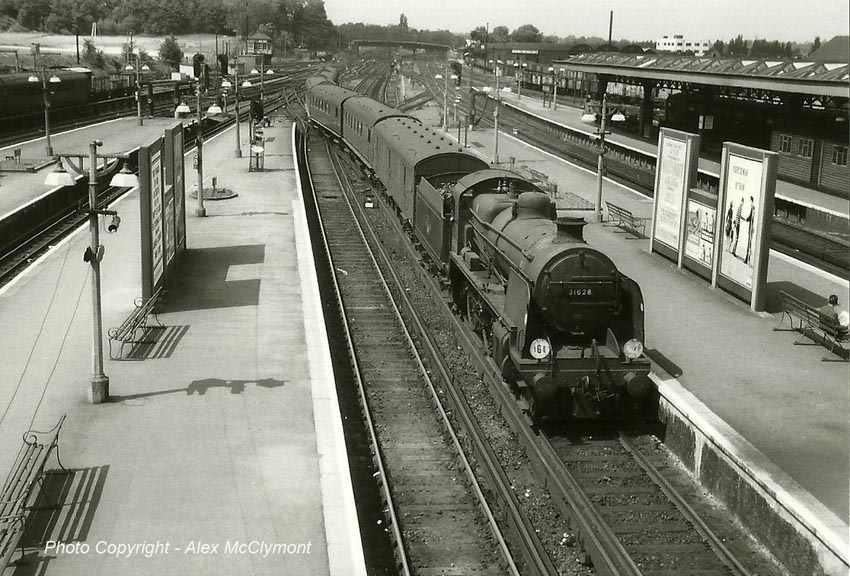Following the success of Geoff Burch's first book 'The Ramblings of a Railwayman' published in 2011 - the 1,000 copies sold out very quickly! Geoff has decided to self-publish a fully revised 2nd edition, lavishly  illustrated with many previously unpublished photographs kindly supplied by Peter Trinder, the late Dave Salmon and Richard S Greenwood MBE. Even though the production costs of a revised 2nd Edition have increased, Geoff has decided to keep to the original price of £20 a copy. However, only a limited number of books will be printed and each one will have a hand-embossed 'Rambling Railwayman Books 70C' crest on the inner cover (with the Author's signature if required) which will make each one especially unique. The book will become available in early April 2016, however demand is expected to be high, so it is advisable to pre-order your copy to avoid disappointment.
illustrated with many previously unpublished photographs kindly supplied by Peter Trinder, the late Dave Salmon and Richard S Greenwood MBE. Even though the production costs of a revised 2nd Edition have increased, Geoff has decided to keep to the original price of £20 a copy. However, only a limited number of books will be printed and each one will have a hand-embossed 'Rambling Railwayman Books 70C' crest on the inner cover (with the Author's signature if required) which will make each one especially unique. The book will become available in early April 2016, however demand is expected to be high, so it is advisable to pre-order your copy to avoid disappointment.
Please contact Geoff HERE for further details.

STEAM DAYS AROUND GUILDFORD - 1
Richard S Greenwood MBE Collection
(Above) Taken on Monday May 29th 1961, this view from Farnham Road Bridge in the Spring sunshine reveals 700 Class 30699 shunting a number of open wagon from Guildford down yard to the dock that was situated next to the Down Cobham line (platform 2). An unidentified 'Schools' class locomotive is about to  leave No 5 platform with a passenger service to Redhill.
leave No 5 platform with a passenger service to Redhill.
(Inset) I had the pleasure of meeting up with celebrated railway photographer, Richard S Greenwood MBE - a major contributor to this site (see left-hand menu to visit his superb pages 53, 87 and 88) - who joined me during a book signing of 'The Ramblings of a Railwayman - 2nd Edition' at the Ian Allan bookshop at Waterloo in May 2016. Richard's photographs are featured extensively throughout the new book; the quality of his work is second to none
(Below) A Horsham - Guildford passenger service headed by E4 Class 32468 runs into the Up Cobham line (platform 3) on the same day; a member of railway staff free-wheels his pushbike towards the foot crossing at the country end of the station. The tail end of a Portsmouth-Waterloo passenger service (4-COR) is just visible in No 6 platform. Note the cut-out speed board situated below the colour light signal denoting the 30mph speed restriction for trains heading towards the tunnel.

(Above-Below) After the E4 class tank had been uncoupled, the crew would normally take water at the column provided at the London end of platform 3 before running round the train. 32468 is about to complete this manoeuvre by running up over the points. Once the points have been reversed and the ground signal cleared, the E4 would then run light engine via the Down Cobham line (platform 2) into the tunnel before backing onto the rear of the train. (Below) This photo shows the train being propelled from the Up Cobham line (platform 3) over the ground signal (the back of which is just visible adjacent to the end of the first coach). The points would then be opened and the ground signal cleared to allow the train to be drawn towards the Down Cobham line (platform 2). Interestingly, a member of station staff is pulling a barrow with a crate containing pigeons which are probably being transferred to an open space for liberation. On the left a passenger service to Ascot is heading towards Pinks Hill and Aldershot - the Driver having already placed the headcode stencil in the frame at the rear of the train (28) to save him time when he changes ends at Aldershot. Guildford station and yards still had quite a number of semaphore signals at that time, the semaphore signal shown being the starting signal for the Bay platform No 1.
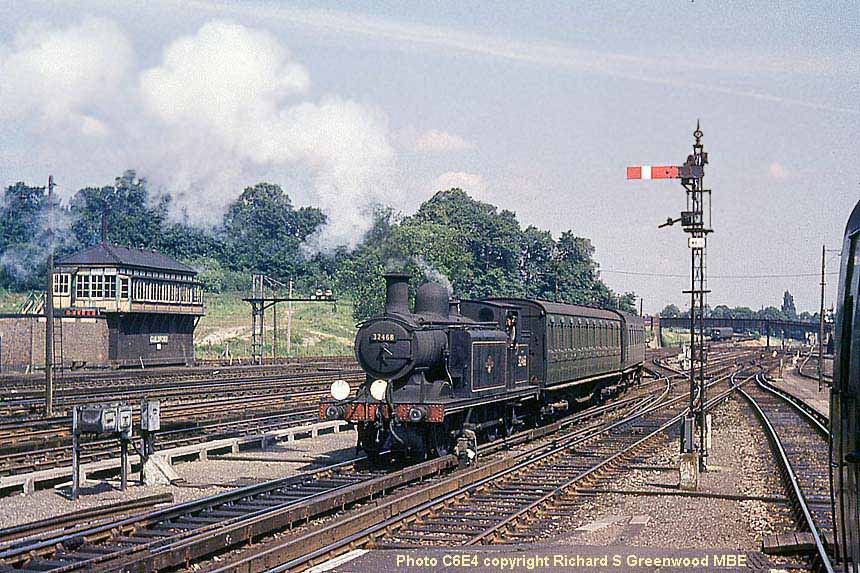
(Above) A few seconds later and the ground signal has been cleared allowing E4 Class 32468 to haul the empty coaching stock towards the Down Cobham line (platform 2). It was not possible to be signalled away from country end of platform 3 as there was only a subsidiary signal provided at that end of the platform. This shunting manoeuvre would have been operated by the signalman in Guildford Yard Box which can be seen in the background. SomethingI hadn't noticed before is the row of six fire-buckets hanging outside the box verandah. The Ascot train that had departed can just be seen beyond Yorkies Bridge climbing the bank towards Pinks Hill.
(Below) Dugald Drummond's 700 Class No 30697 rests on the Coal Road at Guildford on 29th May 1961; it's hard to believe that when this photograph was taken, I was probably less than a hundred yards away cleaning a similar engine. The 700 Class 'Black Motor' locomotive had 'inside motion' and junior cleaner boys such as myself were expected to clean the connecting rods and Stephenson slide valve gear with paraffin; this was done either by clambering across the top of them from the framing above or accessing them from beneath when the loco was berthed over a pit road - a filthy job whichever way you did it; the liquid often ran down your arms or dripped in your eyes. What health & safety? In April 1962, after becoming a passed cleaner and then fireman, I was lucky enough to work on these incredibly versatile locos. No 30697 was withdrawn from service in November 1962 and cut up at Eastleigh in March 1964.

(Above-Below) V Class 'Schools' 30909 'St Paul's' shunts vans behind Guildford South Box on 30th May 1961. This train will form the 11.03am Vans to Woking which was worked by a pair of men in the 'Old Man's Gang' link. Ironically, this was the first locomotive I was assigned to clean on my first day at work on 4th April 1961 and looks as if it needs further attention. The prefabricated hut next to the turntable was partitioned - one half being for the shed turning gang and the far end was for us engine cleaners. The breakdown crane is berthed in the siding next to the New Shed. (Below) E4 Class 0-6-2T 32468 departs from platform 4 with a three-coach set on the 5.04pm Horsham service 31st May 1961. The fireman sits nonchalantly on the side framing as the safety valve blows.


(Above-Below) U Class 31616 coasts into Guildford with the 4.4pm passenger service from Redhill to Reading on 31st May 1961. (Below) This view from Farnham Road Bridge of Guildford Shed shows the fireman of the Mogul standing on the New Pit is waiting to go light engine to Woking; he must have his wits about him as M7 Class 0-4-4T 30249 drifts by from the tunnel. A group of fitters chew the cud over by the crane road in the New Shed as another tends to his duties on B4 Class 0-4-0T 30089 berthed in the Stores Road.

(Above-Below) The fireman of Ivatt Class 2-6-2T 41303 works the injector to keep the engine from blowing off as this Horsham bound train passes under Ferry Lane Bridge on 16th June 1961. The bridge is situated between two tunnels south of Guildford, the first being excavated through chalk whereas the bore for St Catherine's tunnel consisted of sand; it was this tunnel that collapsed in 1895 due to a percolation of water from a burst water main and 1,000 tons of debris fell onto the line, narrowly missing a train. A coach house and stables above the tunnel collapsed into a hole measuring 48 feet wide and 18 feet deep. (Below) Frequent visitors to Guildford were the N15 Class 'King Arthur' - this one being 30796 'Sir Dodinas le Savage' seen here berthed on the coal road at the Coal Stage. waiting her next turn of duty on 25th June 1961. Built between 1919 and 1926, the locomotives were built over several batches at Eastleigh and Glasgow, leading to the nicknames of "Eastleigh Arthurs" and "Scotch Arthurs" in service. The class was subjected to smoke deflection experiments in 1926, becoming the first British class of steam locomotive to be fitted with smoke deflectors. Maunsell's successor, Oliver Bulleid, attempted to improve performance by altering exhaust arrangements. The locomotives continued operating with British Railways (BR) until the end of 1962. One example, 30777 Sir Lamiel, is the only one preserved as part of the National Collection.

(Above-Below) N Class 31871 approaches Shalford which is the first stop on the journey for the 1.04pm passenger service to Redhill on 1st July 1961. The train has just passed over the iron girder bridge which spans the River Wey. I remember walking through the water meadow situated to the right of the photo one summer's day and being amazed at the amount of Snipe that were present. (Below) Same viewpoint but looking in the opposite direction, V Class 'Schools' 30906 'Sherbourne' leaves Shalford and heads towards Guildford with the 1.05pm service to Reading. The semaphore distant signal is at caution indicating to the Driver that the next semaphore stop signal which protects Shalford Junction could be at Danger.

(Above-Below) Guildford based Driver Horace Cummins looks towards Richard taking a photograph of B4 Class 30089 nicknamed 'Little Jim'. Horace was one of the Drivers in the 'Table Gang' that dealt with locomotive movements within the confines of the depot. (Below) A frequent visitor to Guildford was the ex-LBSC C2X Class locomotives which would normally work the Guildford - Leatherhead pick-up freight via the 'New Guildford' line. On 28th June 1961, however, 32545 has only a brake van to convey! Commonly known as Large Vulcans, these locomotives were rebuilds of the C2 Class which originally consisted of fifty-five engines. John Moon & Son's timber merchant's yard, and beyond, the gas works, the Friary Meux brewery and Guildford Castle can be seen in the background.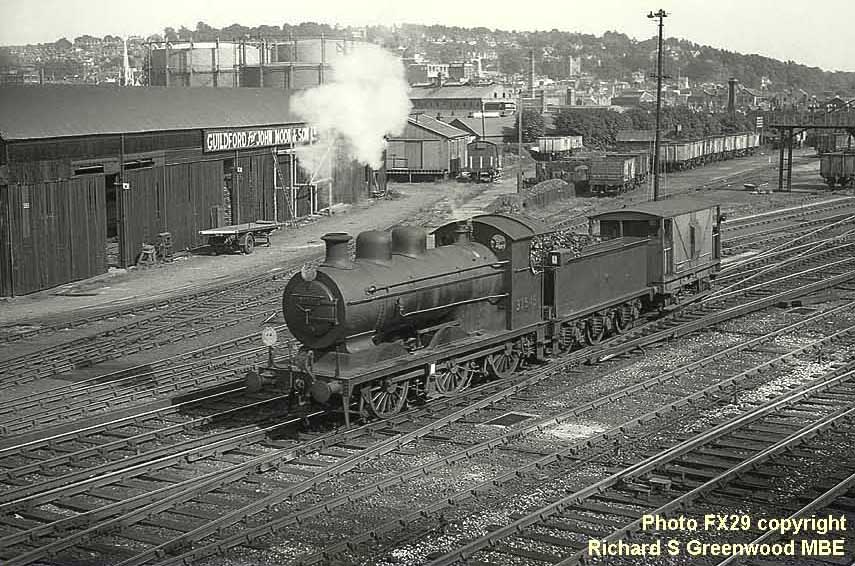
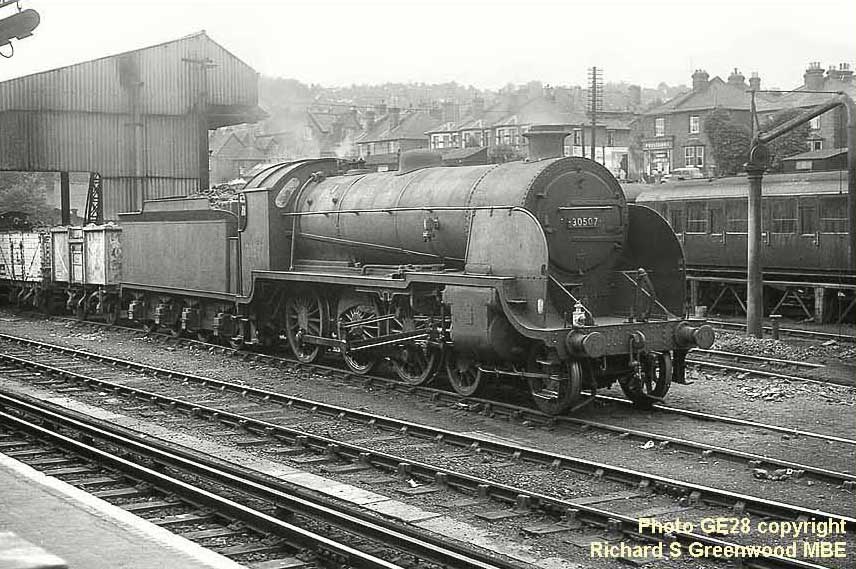
Above-Below) On 18th July 1961, Urie designed S15 Class 30507 rests on the Coal Road awaiting her next turn of duty which would probably be a mixed freight to Feltham her home depot (70B). Introduced in 1920 the S15 was a development of the N15 'King Arthur' Class and used for mixed traffic work. (Below) With cylinder cocks open, L1 Class 31786 leaves Guildford Loco light-engine to Woking on 12th July 1961. Designed by R.E.L. Maunsell and built in 1926 at the North British Locomotive Co., Glasgow Works, these inside-cylinder 4-4-0 express engines worked primarily on London - Folkestone expresses and proved to be very successful. In the mid 1950s, over half of the fifteen locos were allocated to Bricklayers Arms shed in London, where their duties included semi-fast expresses and specials on the South Eastern Section. Most of the class survived into the 1960s.The final base for 31786 was Nine Elms (70A) and the last to survive and was withdrawn in February 1962. 

(Above-Right-Below) Three shots showing the loco variety at Peasmarsh Junction where the single line staff was collected to ensure safe passage over the single line section of the Horsham Branch...here Q1 Class 33024 branches  off the main Portsmouth line and heads toward Bramley & Wonersh station with a Horsham service on 28th June 1961. The route to Horsham was restricted to quite a number of Southern locomotives because of the width and height through Baynards tunnel. The Q1 class however didn't suffer this restriction and one Bank holiday, I remember working two trips from Guildford to Horsham and return with a Q1 Class, my Driver being Ted Greaveshurd. (Inset Right) M7 class 0-4-4T No 30246 heads the 6.5pm Guildford to Horsham past Peasmarsh Junction box (Below) Quite amazing but this is the third BR Standard Class 2MT tank seen in the Guildford area in one week! This time, after receiving the single line staff from the Signalman, 84024 joins the branch line at Peasmarsh Junction with the 6.34pm from Guildford on 21st June 1961. Notice the permanent speed (10) denoting the maximum speed both ways on this junction.
off the main Portsmouth line and heads toward Bramley & Wonersh station with a Horsham service on 28th June 1961. The route to Horsham was restricted to quite a number of Southern locomotives because of the width and height through Baynards tunnel. The Q1 class however didn't suffer this restriction and one Bank holiday, I remember working two trips from Guildford to Horsham and return with a Q1 Class, my Driver being Ted Greaveshurd. (Inset Right) M7 class 0-4-4T No 30246 heads the 6.5pm Guildford to Horsham past Peasmarsh Junction box (Below) Quite amazing but this is the third BR Standard Class 2MT tank seen in the Guildford area in one week! This time, after receiving the single line staff from the Signalman, 84024 joins the branch line at Peasmarsh Junction with the 6.34pm from Guildford on 21st June 1961. Notice the permanent speed (10) denoting the maximum speed both ways on this junction.
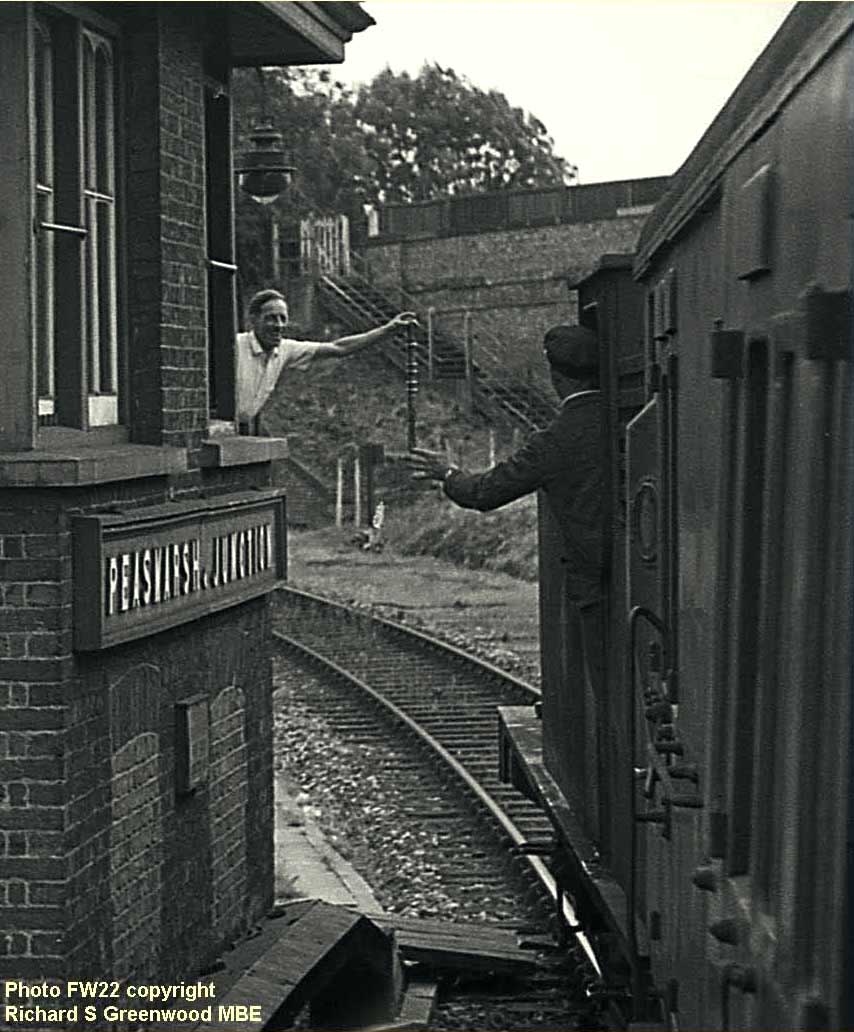
(Above-Below) The Signalman at Peasmarsh Junction signal box prepares to pass the single line staff to the Driver of this Horsham bound service from Guildford on 8th July 1961. The basics of this system are  that a driver must not enter a single line section without being in possession of the train staff. As only one train staff can be removed from the instrument in the signalbox, this guarantees that there can only be one train in the section at any one time. As an added security the Section Signal (the signal protecting the single line) can only be set to clear once. When the signal is returned to Danger it cannot be released until the staff has been returned to the signal box at the other end of the single line and put through an instrument. This instrument resets the lock and enables the signalman to clear the signal once more. A number of tokens were held within the instruments at both ends of the single line in case another train needed to run in the same direction as the first. In these photos the Drivers are being allowed to travel over the single line section as far as Bramley & Wonersh station where he will give up to the staff to the Signalman there. The Driver will then need a further single line staff - and the starting signal to be cleared - to travel over the next portion of single line to Baynards station. (Below) Bramley & Wonersh signalbox 19 June 1961. The station opened in 1865 as 'Bramley', its name being changed in June 1888 to Bramley & Wonersh as the station, although situated in Bramley, was only a short distance from Wonersh. A passing loop and a second platform were installed in 1876.
that a driver must not enter a single line section without being in possession of the train staff. As only one train staff can be removed from the instrument in the signalbox, this guarantees that there can only be one train in the section at any one time. As an added security the Section Signal (the signal protecting the single line) can only be set to clear once. When the signal is returned to Danger it cannot be released until the staff has been returned to the signal box at the other end of the single line and put through an instrument. This instrument resets the lock and enables the signalman to clear the signal once more. A number of tokens were held within the instruments at both ends of the single line in case another train needed to run in the same direction as the first. In these photos the Drivers are being allowed to travel over the single line section as far as Bramley & Wonersh station where he will give up to the staff to the Signalman there. The Driver will then need a further single line staff - and the starting signal to be cleared - to travel over the next portion of single line to Baynards station. (Below) Bramley & Wonersh signalbox 19 June 1961. The station opened in 1865 as 'Bramley', its name being changed in June 1888 to Bramley & Wonersh as the station, although situated in Bramley, was only a short distance from Wonersh. A passing loop and a second platform were installed in 1876.
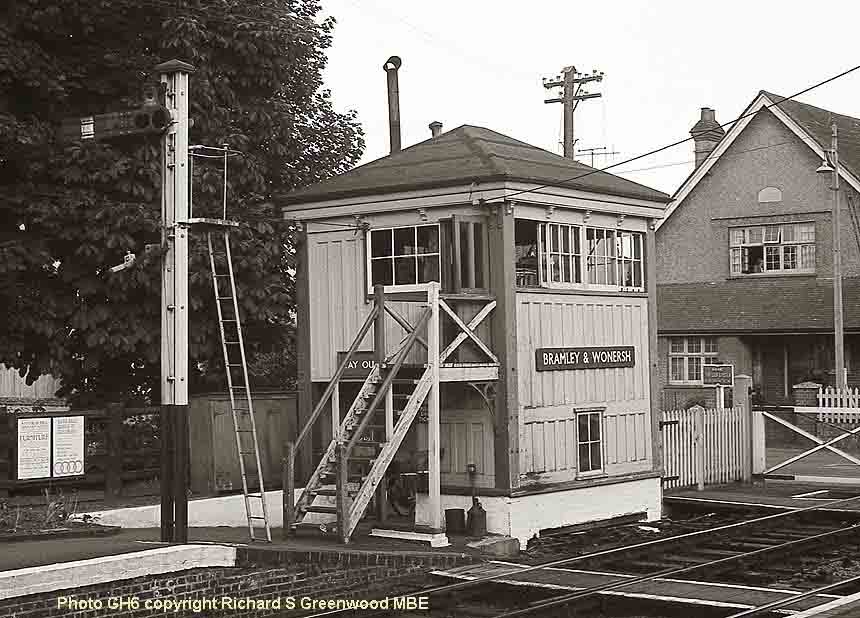

(Above-Below) M7 Class 30246 waits to leave Bramley & Wonersh station with a service to Guildford on 19th June 1961. A Guildford loco (70C) she was one of three M7 Class tanks belonging to Guildford in 1961, the others being 30132 and 30378. Bramley & Wonersh station was the first on the line to Horsham. On 16th December 1942 a train packed with Christmas shoppers was departing from Bramley when it was attacked by a German aircraft. The plane fired its machine gun at the train and dropped a bomb that exploded on the embankment narrowly missing the train. The train was badly damaged and seven people, including the driver and guard, were killed. After closure of the line in 1965, the trackbed remained overgrown for many years before being brought back into use in the 1980s as part of the Downs Link, a public footpath and bridleway linking the North Downs and South Downs National Trails. 
(Below) 23 M7 30378 at Cranleigh on 8th July 1961. Construction of the Horsham & Guildford Direct railway started early in 1862 with five stations planned at Bramley, Cranley, Little Vachery (later changed to Baynards), Rudgwick and Slinfold. The branch opened on 2nd October 1865 and was single track for its entire length with a passing loop at Baynards Station. In 1867, Cranley's name was changed to Cranleigh at the request of the Post Office because badly written letters were sometimes mistaken for Crawley and vice versa. During 1876 passing loops were added at Bramley station and another at Cranleigh in 1880.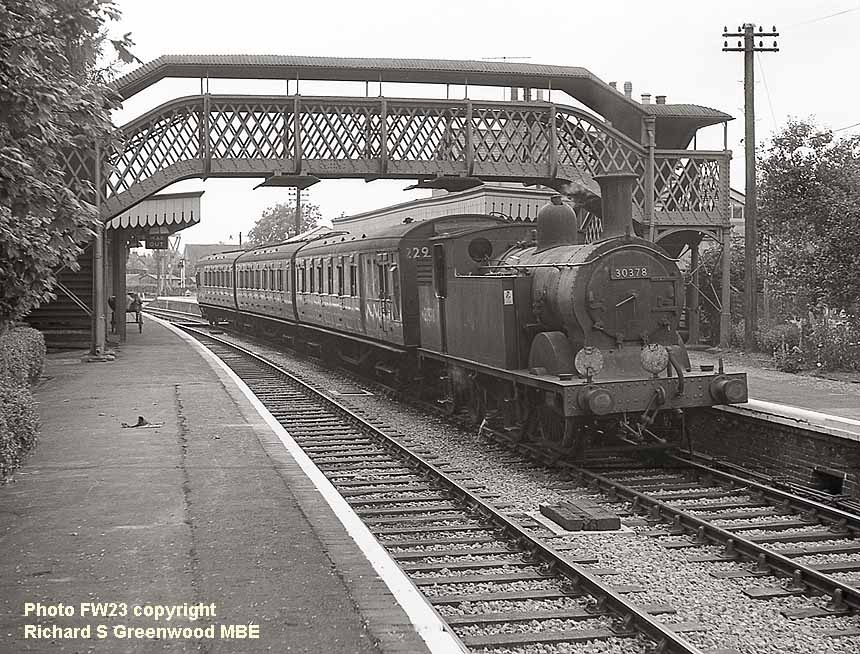

(Above-Below) BR Standard Class 2MT 84025 crew wait patiently for the train from Baynards to enter the station. The Signalman would need to take the train staff from the crew of the incoming service from Baynards and place it in the instrument which would enable another staff to be released and handed to the driver of 84025. The starting signal for the section ahead would also need to be cleared before the train could enter the section. (Below) Cranleigh signalbox was situated on the down platform (the town side) at Cranleigh and as a precaution, three fire buckets full of water are at hand ready for use should there be a fire! A cutout for the signalman's foot can be seen in the side of the platform to aid the climb up from the foot crossing. Sadly, this whole area in now a car park for the town's shopping centre Stocklund Square. Note: Because of the village's famous Public School, V Class 'Schools' 30936 'Cranleigh' was the 36th Schools Class engine, out of a total of 39 that were built at Eastleigh Locomotive Works. Soon after it was built, 'Cranleigh' was put on display at Cranleigh station so that locals (especially boys from the school it was named after) could have a good look around it. The locomotive went into service in June 1935 and spent almost all its life based at Bricklayers Arms, but ended it's days at Nine Elms. She was withdrawn in December 1962, 2½ years before it's home village's station closed. However, it wasn't the first engine to be named 'Cranleigh', from 1886 Stroudley's D1 tank engines worked the line, one named after every village that served the line including 'Cranleigh'.

(Above) M7 Class 30378 heads off towards Baynards station with a Horsham service on 8th July 1961. The signal below the cleared starting signal with an 'S' on its arm, when cleared, would allow a train to pass the starting signal at Danger and enter the section for shunting purposes only. A train staff would not be issued to the Driver. The crossing keeper at Knowle Lane crossing gates (shown further ahead of the train) would also need to place the gates in a position to stop motorists and pedestrians from crossing the line.
(Below) Returning to Guildford, Richard took this fine shot from Yorkie's Bridge of V Class 'Schools' 30915 'Brighton' hauling the 6.55pm passenger service to Reading on 2nd July 1961. In the background can be seen part of the Downs and the old Royal Surrey County Hospital.
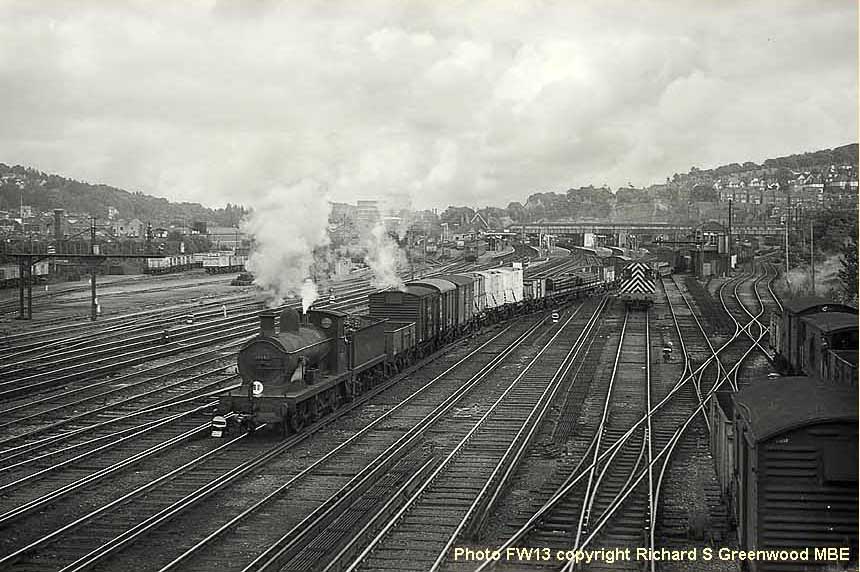
(Above-Below) A few days later and Richard is back on Yorkie's Bridge to capture C Class 31510 departing Guildford Up Yard with a heavy mixed freight for Woking Yard on the 5th July. The fireman can be seen leaning from the cab to observe the rear of the train - and (below) he continues a vigilant lookout in this going-away shot from the opposite side of the bridge. Rule 142 (clause d) of the 1950 Rule Book says the Driver must, if necessary give a short whistle to gain the attention of the Guard for the purpose of exchanging hand signals. The Guards signal to the Fireman must be shown from the guard's van and by day will be given by holding one arm above the head and at night or during fog or falling snow by waving a green light slowly from side to side, which latter signal must be acknowledged by the Fireman holding a white light steadily. (My thanks to Pat Kinsella for this 1950 Rule Book information). Note the remains of WW2 camouflage markings on the electricity sub-station on the right.

Early Spotting Days at Brookwood Station - Geoff Burch
As I lived in the village of Worplesdon (some 2½ miles away) it didn't take long for me to pushbike to the nearest main line station at Brookwood to quench a passion for 'spotting' Bulleid Pacific locomotives in full flight - the original design of these locos being nicknamed 'Flat-Tops!
The station didn't possess an over-bridge but instead, had an under-pass which connected the Up and Down local platforms; the two 'through' roads not having platforms. There was a small viewing area adjoining the Up side platform where you could watch trains coming and going. This was surrounded by 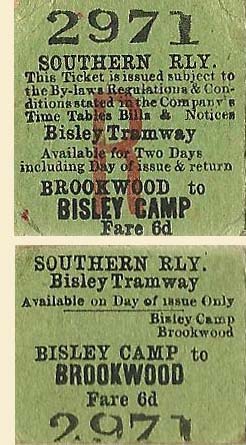 metal-railings and as it didn't occupy an area of the platform you didn't require a platform ticket. Obviously, in some cases when an Up slow train came into the station, you couldn't see anything passing through the station on the down lines but this didn't happen very often.
metal-railings and as it didn't occupy an area of the platform you didn't require a platform ticket. Obviously, in some cases when an Up slow train came into the station, you couldn't see anything passing through the station on the down lines but this didn't happen very often.
In the years before my spotting days began, a Push-Pull train service nicknamed the 'Bisley Bullet' ran from Brookwood to Bisley Camp and its Rifle ranges from a bay platform situated next to the Up local line up until July 1952. (Below) Here Class O2 tank awaits departure from Brookwood for the run to Bisley Ranges. The tickets (right) are most certainly from the last passenger service that ran in 1952. They were passed to me by my brother, whose wife's uncle had pasted it into an old scrap album. There's another story to go with this...the train robbery that was featured in the 1960s film 'Two Way Stretch' with Peter Sellars, was filmed at Pirbright Arch which runs under the main line and also the old Bisley line near Brookwood. During one night's filming on the Bisley line they utilised Guildford's Steam Breakdown Crane...the driver at the filming was Don Ottignon (now aged 87).

(Above-Inset-Below) Salisbury-London semi-stopping service runs through Brookwood station on its way  to Waterloo on 28th June 1961. The train is headed by Rebuilt West Country Class 34005 'Barnstaple'. The metal-railings enclosure adjacent to the Up platform can be seen just in front of the locomotive. (Below) Rebuilt West Country Class 34097 'Holsworthy' hurtles through Brookwood on the Down Through line with a Waterloo-Exeter passenger service on 28th June 1961. Brookwood station's goods shed can be seen in the background within the confines of the Up Yard. This shot (inset right) of WC Class 34028 'Eddystone' provides a clearer view of the two-aspect colour light distant signals on the gantry, which replaced the lower quadrant distant signals originally sited below the starting signals.
to Waterloo on 28th June 1961. The train is headed by Rebuilt West Country Class 34005 'Barnstaple'. The metal-railings enclosure adjacent to the Up platform can be seen just in front of the locomotive. (Below) Rebuilt West Country Class 34097 'Holsworthy' hurtles through Brookwood on the Down Through line with a Waterloo-Exeter passenger service on 28th June 1961. Brookwood station's goods shed can be seen in the background within the confines of the Up Yard. This shot (inset right) of WC Class 34028 'Eddystone' provides a clearer view of the two-aspect colour light distant signals on the gantry, which replaced the lower quadrant distant signals originally sited below the starting signals.

(Above-Below) N15 'King Arthur' Class 30804 'Sir Cador of Cornwall' heads a mixed van train through Brookwood heading for Clapham Loop on 28th June 1961.The Loop line at Clapham Junction would allow the vans to be drawn forward into the Up yard and propelled back into the reception sidings.
A sign on the station platform reads: 'Necropolis - Brookwood Cemetery'. This dates back to the times before WW2 when funeral trains ran from the former Waterloo 'Necropolis' station to Brookwood Cemetery which at that time was the largest cemetery in the world. The two stations within the Cemetery (one for non-conformists and the other for Anglicans) were accessed via the down local line (the signal shown on the very left of the gantry at the end of the platform). The train would then be propelled to the stations (via a line that ran behind the back of the signal box) under supervision of the Guard of the train. Upon completion of the work at the Cemetery, the train would be drawn forward to a loop line where the engine would be detached and after running round the train, propelled into the siding, from whence it would be drawn to the Up Line. The shunting operations were supervised by a member of Brookwood station staff. The points of the siding to the Cemetery were worked by a ground frame that was controlled by an Annett's key attached to the train staff...
In railway signalling, an Annett's key is a large key that locks levers or other signalling apparatus thereby functioning as a portable form of interlocking. Named after its inventor J.E. Annett, of the London, Brighton and South Coast Railway, they have been made in a variety of forms. The keys and locks are given a matching configuration to prevent keys of a different configuration being inserted into the wrong lock.The funeral trains stopped running when the London terminus (Necropolis) was bombed in 1941...a section of track has been laid to commemorate the cemetry railway. Click on photo-link below to see the full image..

Above-Below) An elderly gent looks on as West Country Class 34041 'Wilton' passes through Brookwood with an Up Bournemouth - Waterloo passenger service on 28th June 1961. The pneumatic lower quadrant signals situated on the gantry at the end of the platform on the down line were worked by compressed air instead of the usual wires attached to the signal frame levers. The two signals in the clear position are for a train on the Down local line. The Distant signal to the left of this when cleared, would indicate to the Driver that the route was set and the signals were in the clear position for the line to Ash Vale via Pirbright Junction. (Below) This photo provides a better view of the metal-railing enclosure where I did my train spotting. Dubbed the 'Cage' by local spotters a crowd of youngsters have gathered to watch trains. In the final shot beneath it is a mixed freight from Basingstoke to Woking Up Yard on the Up local line on 28th June 1961. Note that only the Up and Down local lines on the main line to Basingstoke were electrified at this time; the conductor rails were only in place as far as Sturt Lane Junction to allow electric trains to run via the spur to Frimley Junction. Full electrification on all lines from Waterloo to Bournemouth were finally completed in 1966.

STEAM DAYS AROUND GUILDFORD - 2
(Below) Guildford-based V Class 'Schools' 30906 'Sherborne' races through Vauxhall with the 12.54pm Waterloo to ![]() Salisbury passenger service on 17th June 1959. The Houses of Parliament and 'Big Ben' can clearly be seen in the background. During my early days as a fireman back in 1962, I had the pleasure of working on this loco along with my regular Driver at the time, Charlie Lyford, in the Old Man's Gang.
Salisbury passenger service on 17th June 1959. The Houses of Parliament and 'Big Ben' can clearly be seen in the background. During my early days as a fireman back in 1962, I had the pleasure of working on this loco along with my regular Driver at the time, Charlie Lyford, in the Old Man's Gang.

(Above-Below) V Class 'Schools' 30903 'Charterhouse' prepares to leave Waterloo with the 12.54pm semi-fast passenger service for Salisbury circa 1958. As can be seen on the smokebox, she was then a Nine  Elms locomotive (70A). She was transferred to Guildford shed where she ended her days along with 30906 'Sherbourne' and 30909 'St Paul's'. (Below) Spotters look on as Merchant Navy Class 35019 'French Line CGT' departs platform 11 at Waterloo with a Bournemouth service circa 1958. Built at Eastleigh with air smoothed casing and chain driven Bulleid valve gear (original number 21C19), all 30 of the class were modified from 1956 - 1959 with lower boiler pressure, Walschaerts valve gear, multiple-jet blastpipe and large diameter chimney and Air smoothed casing removed.
Elms locomotive (70A). She was transferred to Guildford shed where she ended her days along with 30906 'Sherbourne' and 30909 'St Paul's'. (Below) Spotters look on as Merchant Navy Class 35019 'French Line CGT' departs platform 11 at Waterloo with a Bournemouth service circa 1958. Built at Eastleigh with air smoothed casing and chain driven Bulleid valve gear (original number 21C19), all 30 of the class were modified from 1956 - 1959 with lower boiler pressure, Walschaerts valve gear, multiple-jet blastpipe and large diameter chimney and Air smoothed casing removed. 

(Above) Looking resplendent in the morning sunshine, Rebuilt Merchant Navy Class 35009 'Shaw Savill' prepares to depart platform 10 at Waterloo with an Exeter service. Originally built at Eastleigh Works in her original air-smoothed casing form (number 21C9), she was allocated to Salisbury shed in wartime black livery. Rebuilt in 1957 she travelled 1,127,452 miles before being withdrawn from service in July 1964.
(Below) With safety valve simmering, V Class 'Schools' 30911 'Dover leaves platform 6-7 with a Redhill to Reading service circa 1960. Designed with a 4-4-0 wheel arrangement, these locomotives were the most powerful class of 4-4-0 ever produced in Europe. All 40 of the class were named after English public schools, and were designed to provide a powerful class of intermediate express passenger locomotive for lines which could cope with high axle loads but some of which had short turntables. The class operated until 1961 when mass withdrawals took place and all had gone by December 1962. Three examples are now preserved on heritage railways in Britain. A 2BIL electric service can be seen on platform 8 (stencil headcode 21) which would form the half-hourly passenger service to Ascot (via Aldershot).
Interestingly, the small flat-roofed building that can be seen on platform 3, housed the station announcer - 'Guildford, this is Guildford!'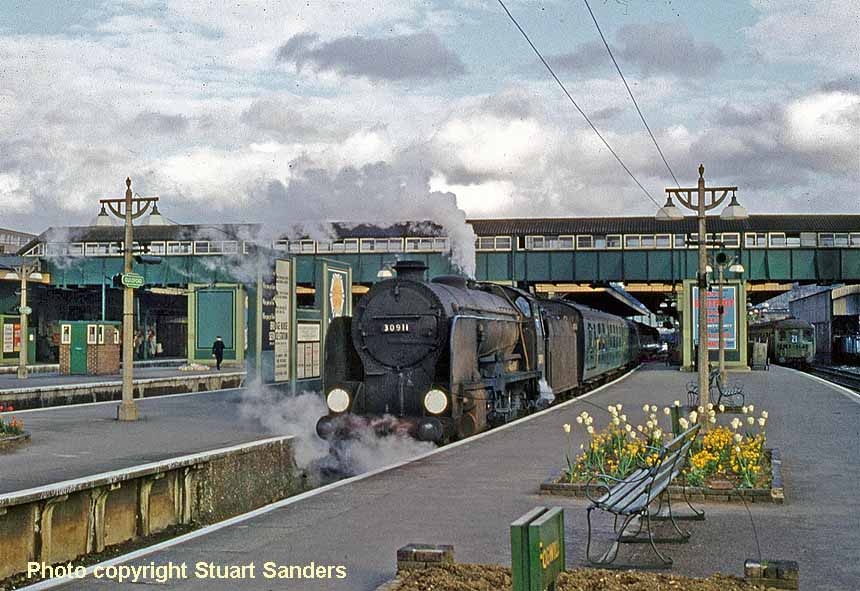

(Above-Below) This photograph of the ex-SR 'Battle of Britain' light Pacific No 34056 on the Coal Road at Guildford in the summer of 1966 gives a good view of the 'Croydon' nameplate and enamel badge depicting the RAF crest. Built at Brighton in February 1947 the locomotive was originally numbered 21C156 and named after the Second World War RAF airfield. It was allocated new to Dover and later Ramsgate, Stewarts Lane, Nine Elms, Exmouth Junction and Salisbury from where it was withdrawn on 7 May 1967 and sold for scrap to Cashmores at Newport, entering the breaker's yard on 16 October 1967. (Below) This splendid ex-loco condition nameplate and badge, plus the original steel backplate which was fitted when the engine was rebuilt - went under the hammer for £35,000 at a Great Central Railwyana Auction on 11th October 2014. 
(Below) B4 Class 30089 'Little Jim' on shed shunting duties at Guildford MPD. Although this photo was included in my book, I didn't realise that it could have been taken at a very significant moment in my railway career. A V Class 'Schools' is in the next road and the tender has been partially cleaned (head high). Could this be 30909 on my first day at work??
(Above-Below) Above: 700 Class 30325 stands amongst the foliage at Farringdon (the first station after leaving Alton on the Meon Valley line). She's just worked the 5am freight from Woking with Driver Ackehurst and fireman Frank Saxby. The Meon Valley line had one crucial role to play in the D-Day operations. On June 2nd 1944, Winston Churchill, US General Dwight D Eisenhower, the Prime Ministers of Canada and South Africa, and other Allied leaders met in a special train at Droxford Station (the train was actually the Royal Train from the LMSR). The station possessed the longest siding in southern England outside the works at Eastleigh) and was close to a deep cutting. If threatened by an air raid, the train could be pushed into the relative safety of the cutting. During this meeting, final decisions regarding the planning of Operation Overlord were made. The Meon Valley line closed for passenger traffic on the 5th February 1955 and a goods service to Farringdon was maintained until 1968, when the final part of the Meon Valley Railway was closed to all traffic. None of the 700 Class of locomotive survived the cutter's torch which was an absolute travesty. (Below) E4 Class 32479 replenishes her tanks at the water column on the New Pit at Guildford MPD. She was withdrawn from service in June 1963. The Store's windows can be seen situated behind the bunker and the Shedmaster's office was situated above the Stores. I have just been notified by Jim Lester. who contributes a tremendous amount of material for the Nine Elms Website, that a review of my latest book has been posted on the site here...many thanks to John McIvor of SVS Films for kindly publishing the review.
(Above-Below) M7 Class 30053 at Clapham Junction. In 1961, three of this class of locomotive were stabled at Guildford MPD - 30124, 30246 and 30378 - used mainly on the Guildford - Horsham branch until they were superseded by the Ivatt Class tank engines. As an engine cleaner, I had my first ever ride on the footplate on the main line on one of these locomotives - even though it was only a few hundred yards! (Below) 30053 strutting her stuff on a Woking Centenary special. This M7 Class 30053 (designed by Dugald Drummond) was withdrawn from BR service in 1964. She was then shipped to America and spent twenty years there before returning to dear old Blighty. She now resides at the Swanage Railway. Dugald Drummond is buried in Brookwood Cemetery only a couple of miles from where I live.

(Above-Below) In its Heyday (no pun intended David) Guildford had two signalboxes: this one (above) which was situated directly opposite the Motive Power Depot, just before the chalk tunnel, and Guildford Yard Box which was situated at the Northern end of the station at Guildford Up Yard, just visible in the shot below. (Below) Several Ivatt 2MT 'Teddy Bear' tank engines were allocated to Guildford loco to cover a variety of turns including working over the Guildford-Horsham branch. They were a nice loco to work on and steamed well. Introduced between 1946 and 1952 the locos were based on the LMS Stanier 2-6-2T. Ten were built by the LMS (Nos 1200-9) before nationalisation in 1948. British Railways added the prefix '4' to their numbers so they became 41200-9. A further 120 were built by BR, numbered 41210-41329 in the fleet. Most were built at Crewe but the last ten were built at Derby. The last thirty Crewe-built engines Nos 41290-41319 were allocated to the Southern Region from new. Sporting a 6G shedplate on the smokebox door suggest that LMS Ivatt 41230 has recently transferred from Llandudno Junction on the London Midland Region. Here the bag is in at the London end of platform 3 (Up Cobham) prior to running round the train for the return trip to Horsham on 31st August 1963. Guildford North Signal Box can be seen in the background along with a 350hp shunting loco in Guildford Up Yard. 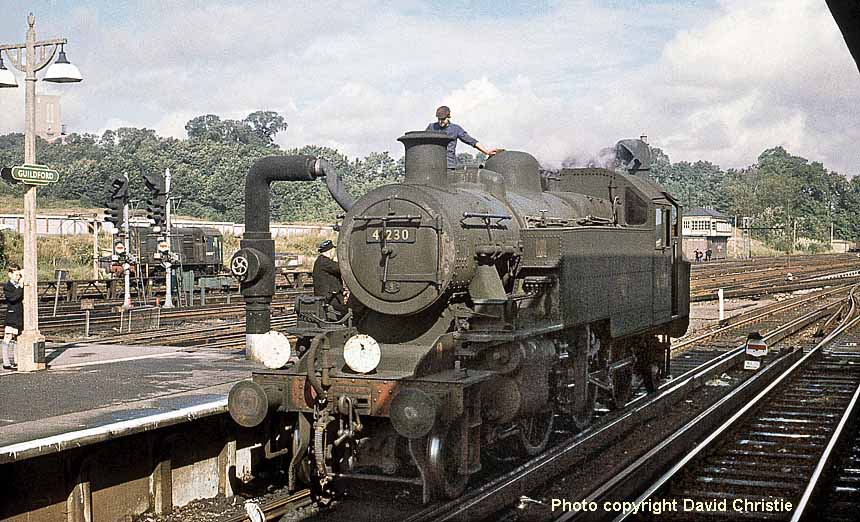

(Above-Below) LMS Ivatt 41294 runs into platform 2 (Down Cobham) with empty coaching stock for a passenger service to Horsham. The small square brick building on platform 3 is the station announcer's office! (Below) LMS Ivatt Tank 41301 shunts behind the back of Guildford South Box. These locomotives replaced the M7 tank locomotives when they withdrawn from service in 1964 and were utilised mainly on the Guildford - Horsham line.They were splendid workhorses and were much more comfortable than the M7 tanks - Disposal duties were much better too as they all had rocking grates to ease the burden of cleaning the clinker out of the fire.
(Above-Below) Guildford MPD also had its own coalstage which was situated next to Platform 8 at Guildford station; skips of coal were hoisted by electric cranes and emptied by the release of a handle on the side of the skip. The whole area was screened from view from the station be corrugated asbestos sheeting. Disposal duties were also carried out here - smokeboxes of locomotives were emptied of ash, fires cleaned of clinker and ash pans raked out by clambering into the pit below the locomotive...first making sure which way the wind was blowing! N Class 31812 is in the process of being disposed. (Below) The normal entrance to the coalstage - Rebuilt Battle of Britain Class 34056 'Croydon' waits to be coaled and BR Standard Class 4 76016 stands in the Back road awaiting further duties. Guildford's Platform 8 can be seen on the left of the photograph.
(Above-Below) Rebuilt Battle of Britain Class 34090 'Sir Eustace Missenden, Southern Railway' (devoid of nameplates) stands at the southern end of the coalstage following disposal. The Guildford turntable wasn't large enough to cater for any Bulleid Pacific so if the locomotive needed turning, it had to done via a triangle (usually via Addlestone Junction and Weybridge). (Below) An unusual locomotive to be utilised on the breakdown crane - Rebuilt West Country Class 34045 'Ottery St. Mary' stands at the far end of the breakdown crane road just outside the mouth of the chalk tunnel.
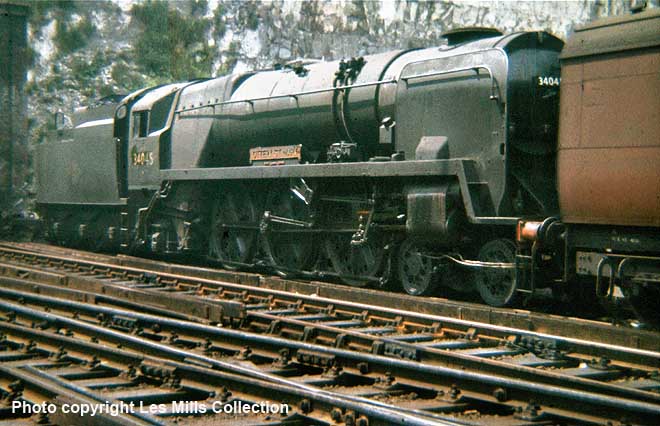
(Above-Below) USA Class 30064 became the Shed Pilot after B4 Class 30089's departure to Eastleigh to be scrapped. I can't say that I liked them but suppose they had their merits. (Below) The final Shed Pilot at Guildford USA Class 30072 - which had the honour of being the last steam locomotive to leave the depot on the Sunday 9th July 1967 when the depot closed.


(Above-Below) The Back Road towards the coalstage is chocker block with locomotives - some I suspect waiting to be hauled away to be scrapped at Eastleigh. (Below) The turntable sits quietly waiting for its next customer as other locomotives wait patiently for their next turn of duty. The Shed Pilot - B4 Class 30089 is in the foreground.
(Above-Below) The Reading - Redhill line was Guildford's 'bread and butter work' and was a fantastic line to work over. I was never bored with the line as its topography and scenery was splendid especially between Shalford and Redhill. In this photograph, U Class 31627 climbs out of Guildford up Pink's Hill bank at Deerbarn foot crossing with a Reading bound stopping service. (Below) Another U Class 31428 runs into platform 4 at Guildford with a stopping service to Redhill.
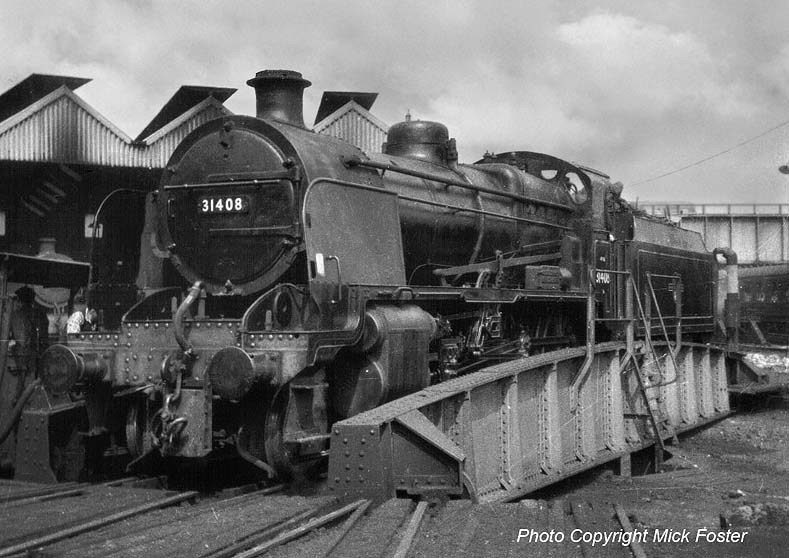
(Above-Below) N Class 31408 in the process of being turned on the turntable at Guildford MPD. Note that not all N Class locomotives were 'right' handed'. (Below) Former 'River' Class 803 'River Itchen' now converted to U Class 31803 is about to pass Guildford South Box heading for Redhill with the Blisworth Vans. The 'River' class tanks were all converted to tender engines after a fatal derailment at Sevenoaks, No 800 'River Cray' being involved in the accident. 

(Above-Below) This interesting shot was sent to me by Mike Fracklewicz of the Maunsell Locomotive Society and shows U Class 31638 departing from platform 5 at Guildford with the 10.04 am passenger service to Redhill on the 26th April 1962. Waiting for its pathway, S15 Class 30847 stands at the signal on platform 2 with a stone train from Woking heading for the same destination and then on to either Three Bridges or Tonbridge. A quirk of fate became of these locomotives as they were both saved from the cutter's torch and are now in the safe hands of the Maunsell Locomotive Society Railway link here. (Below) Fast-forward to 2nd October 1968 and this busy scene taken from Farnham Road Bridge shows from left to right - 4COR 3126 forming the rear part of a Portsmouth - Waterloo Semi-fast service about to depart platform 5; 2BIL 2086 (headcode 73) forming the front part of the stopping service to Portsmouth & Southsea on platform 4; 2BIL 2152 forming the rear part of the stopping service from Portsmouth & Southsea to Waterloo on platform 3 and finally, Type3 1550hp Crompton waiting to leave with a van train to Redhill (headcode 55) from platform 2.

MEMORIES OF GUILDFORD STATION - 1
Jeffrey Lloyd Collection
After steam ended in 1967, Guildford station was in desperate need of modernisation, but it would take several more years before work began on updating the premises in the late 1980s. These photographs were taken in 1967 and show just how dilapidated things were. (Below) A ticket Inspector stands guard on No 2 platform barrier as the tobacconist's shop proprietor assesses the stock. The station is completely run down and it will be still some time before the station is completely modernised. As can be seen by the posters, Estate Agents were plentiful even in those days!

(Above-Below) This is the 'mobile' canteen used by Guildford railway staff but here it is standing empty and awaiting demolition. It was positioned on the dock adjacent to No 2 platform where railwaymen enjoyed many mugs of tea and oatmeal cakes there. (Below) A view from No 2 platform (Down Cobham) towards No 3 platform (Up Cobham) and No. 4 platform (Down Portsmouth line). An interesting hoarding advertises 'Learn to Fly at Cobham'...a lot quicker to get to one's destination but slightly more expensive than a second class day return!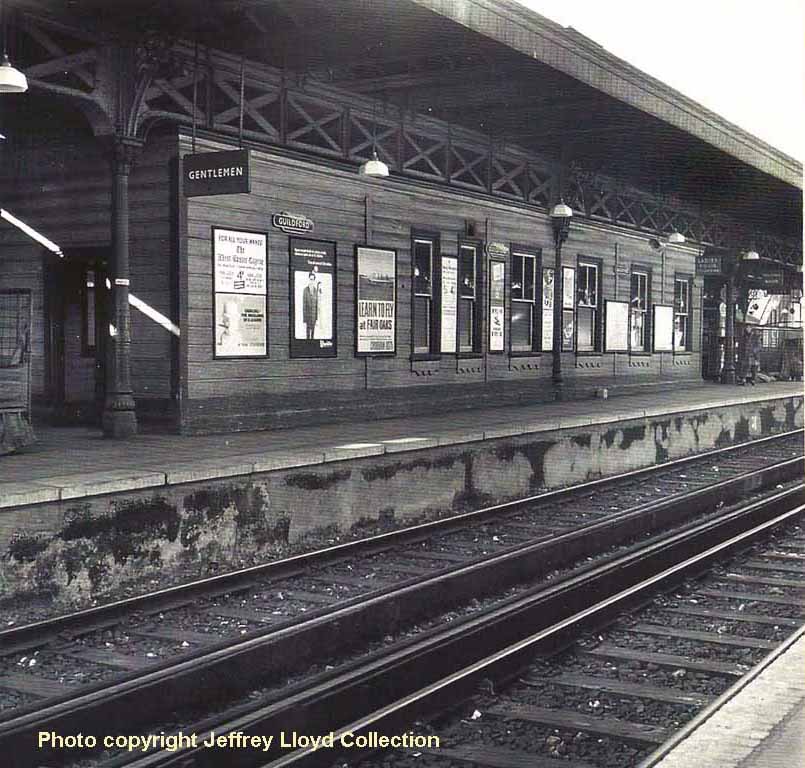

(Above-Inset-Below) A fine array of cars parked outside the station - and not a foreign make amongst them! (Inset) The staff exit at the end of No. 1 platform (the Down Bay). There would often be a stream of passengers using this gate to exit the station, some of whom I'm sure without a valid ticket of travel). It used to really make my blood boil. Why is it that trying to get away with not paying to travel on a train is somehow termed as acceptable? Surely it's just the same as going into a shop and taking something without paying. This was also the scene of a train crash on 18th September 1953 when the 3.12 p.m. train from Waterloo to Guildford, formed of 4 EPB units 5003 and 5015, was approaching Platform 1 at Guildford  station, a bay platform with a sand drag and stop-blocks at the end. The body of the leading car of unit 5003 overrode the stop-blocks and embedded itself in a block of station offices, injuring two passengers and five station staff members, one of whom later died of his injuries. A full report is featured on Page 72. (Below) The mode of transport for many Drivers and Guards was a motorcycle or moped and as there was no shelter, many would be parked at the Country end of No 2 platform (outside of the Gentlemen's Toilet and adjacent to the Guard's and Driver's room). One notable 'steed' on its stand is a Triumph 'Thruxton' Bonneville (belonging to Driver Charlie Hampshire). Triumph showed a pre-production model of the Thruxton Bonneville at the Earls Court Show in 1964. The intention was to produce a machine that would be capable of winning the prestigious Thruxton 500 Miler endurance race. The bike was developed from the T120 Bonneville and made available to the home market in limited numbers. Only fifty two Thruxtons were ever factory-built to the original spec in May 1965. This was enough to meet the FIM requirements for production racing. I borrowed this bike from Charlie on many occasions (when my Triumph Tiger100 was out of action) and it was an incredible bike to ride especially with its close-ratio gearbox. In 1968, I had the honour of riding it to Commerfords at Thames Ditton where Charlie sold it for £250. The bike would fetch £25,000 in today's money! A 3-Car DEMU (Tadpole) is berthed in the dock for reasons unknown.
station, a bay platform with a sand drag and stop-blocks at the end. The body of the leading car of unit 5003 overrode the stop-blocks and embedded itself in a block of station offices, injuring two passengers and five station staff members, one of whom later died of his injuries. A full report is featured on Page 72. (Below) The mode of transport for many Drivers and Guards was a motorcycle or moped and as there was no shelter, many would be parked at the Country end of No 2 platform (outside of the Gentlemen's Toilet and adjacent to the Guard's and Driver's room). One notable 'steed' on its stand is a Triumph 'Thruxton' Bonneville (belonging to Driver Charlie Hampshire). Triumph showed a pre-production model of the Thruxton Bonneville at the Earls Court Show in 1964. The intention was to produce a machine that would be capable of winning the prestigious Thruxton 500 Miler endurance race. The bike was developed from the T120 Bonneville and made available to the home market in limited numbers. Only fifty two Thruxtons were ever factory-built to the original spec in May 1965. This was enough to meet the FIM requirements for production racing. I borrowed this bike from Charlie on many occasions (when my Triumph Tiger100 was out of action) and it was an incredible bike to ride especially with its close-ratio gearbox. In 1968, I had the honour of riding it to Commerfords at Thames Ditton where Charlie sold it for £250. The bike would fetch £25,000 in today's money! A 3-Car DEMU (Tadpole) is berthed in the dock for reasons unknown.

(Above Left-Right-Below) The EMU Drivers' Room (left) and the Guards' Room which were situated next to the dock at the Country end of No 2 platform. (Below) More examples of classic cars outside the station adjacent to the parcels office.

(Above) A view of the road heading to the Down Yard Goods Shed and yet more classic cars parked neatly on the edges adjacent to Walnut Tree Close...if there are any visiting 'Petrol Heads' who can identify the cars in the above photos I'd dearly love to hear from them. My email address is at the bottom of the page....
MEMORIES OF GUILDFORD STATION - 2
Photographs by Pat Kinsella
Guildford station's main building just before it was demolished circa 1987-88. A taped off row of railway sleepers has been placed in front of the building but doesn't seem to deter the person walking by. Even the photo-booth still seems to be in use. When I first started work at Guildford in 1961 there were a number of small shops in Guildford station approach. They were a cafe-snack bar called the 'Royal Arms'; a philatelist selling coins and stamps called 'GH Bain' (the proprieter being Gordon 'Jock' Bain); a tobacconist's called 'L.W. Hart' and a gent's hairdressers called 'Stewarts'. In this photograph circa 1987-88, the philatelists shop had turned into a shoe repairers and the notice in the window (posted by Henry Jones Construction) is apologising for any inconvenience. The Dry Cleaners shop next door was called 'Trend'. Visible on the left is a poster for the Odeon cinema; there were four cinemas in Guildford during the 1960s - the Plaza (in Onslow St), the Cinema (later to become the Astor and Studio 1 & 2 in Woodbridge Road), the Playhouse (Tunsgate) and the Odeon at the top of Upper High Street. The Odeon cinema hoarding is advertising three films - Screen 1 'Wish You Were Here' starring Emily Lloyd and Tom Bell in which I recall she often repeated the phrase 'Up your Bum'! The movie was based loosely on the memoirs of the British madam Cynthia Payne as an adolescent. It was filmed in Worthing and Bognor Regis. Screen 2 is showing 'Robocop' an American science fiction action film, but the film title on Screen 3 is obscured. In the left background a JCB can be seen in progress on site.
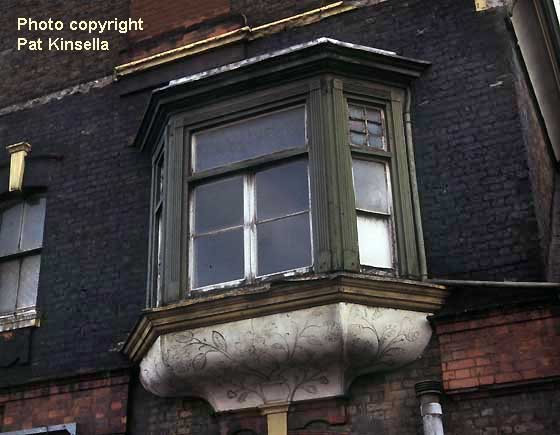
(Above-Below) This ornate Oriel window frame has a decorated corbelling in a pleasing 'Flowers in a Vase Scroll' design. Apparently, 'Bay' windows are only so called when they extend from the ground and not on upper storeys. (Below) This beautiful cast iron stanchion was one of many pillars that were used to support the roof areas over the platforms when the station was rebuilt in 1880. The hollow centre also acted as a drain pipe for any rain water that collected on the roof. 

(Above-Below) W.H. Smiths bookstall is still standing on platform 2 at Guildford but not for much longer as the Guildford station buildings are demolished to make way for a new station. (Below) This 'Lion's Head' drinking fountain dated 1887 was originally situated outside the station's main building. Luckily, it survived the wrecking crew and is now placed inside the booking hall alongside a memorial plaque commemorating members of railway staff that perished during WW1 and WW2.
(Below) Train Spotting memories! The now-preserved N15 'King Arthur' Class 30777 Sir Lamiel at  Woking...this was the first locomotive that I ever cabbed as a 13 year-old boy in the late 50s. I was train spotting at Woking station and the loco was in the down bay. That's why she's depicted on the front cover of my book. (Below) Talk about coincidences...this superb Peter Fitton photo of 777 residing in the Down Bay at Woking on 9th September 1959 was taken at the very same spot I cabbed her all those years ago. The headcode denotes that she's about to work a train or go light engine to Basingstoke. Cabbing Sir Lamiel was the starting point of my railway career.
Woking...this was the first locomotive that I ever cabbed as a 13 year-old boy in the late 50s. I was train spotting at Woking station and the loco was in the down bay. That's why she's depicted on the front cover of my book. (Below) Talk about coincidences...this superb Peter Fitton photo of 777 residing in the Down Bay at Woking on 9th September 1959 was taken at the very same spot I cabbed her all those years ago. The headcode denotes that she's about to work a train or go light engine to Basingstoke. Cabbing Sir Lamiel was the starting point of my railway career.
Ben Darnton, of Ben's Collectors Records Tunsgate, Guildford, has kindly written a review on another of Geoff's presentations which he gave to the 2013 Guildford book festival, held at the Salters Room in Castle Street, Guildford on Saturday January 12th. Ben writes: - 'Geoff Burch recently launched his second railway book, 'Further Ramblings of Railwaymen' which is about his colleague's experiences of life at Guildford's  busy steam depot in the 1960s. As late as 1964, there were nearly 400 people employed looking after and driving the steam locomotives. The talk was accompanied by many rare shots of the once impressive engine sheds, coaling stage and turntable which are now sadly covered over by the Farnham Road car park. Geoff recounted some of his fellow colleague's stories from the Isle Of Wight, Eastleigh, Salisbury and Weymouth depots but the most amazing tale was from his Guildford colleague, then fireman Pat Kinsella, who in heavy snow of the winter of 1963, with a Q1 class steam engine, chased a runaway electric train with no brakes and dozens of unsuspecting passengers running backwards from Haslemere with no driver or guard on board! The train eventually stopped on a gradient near Liphook and a relieved Pat and his Driver propelled it towards Liphook station and safety. This and many other tales kept the audience of local historians and steam buffs enthralled. Geoff is an excellent speaker and is happy to speak at any U3A groups or local history gatherings and can be contacted via his email address at the bottom of the page. Both Geoff's books are available by contacting him directly or at Guildford Museum or Ben's Collectors Records in Tunsgate, Guildford.
busy steam depot in the 1960s. As late as 1964, there were nearly 400 people employed looking after and driving the steam locomotives. The talk was accompanied by many rare shots of the once impressive engine sheds, coaling stage and turntable which are now sadly covered over by the Farnham Road car park. Geoff recounted some of his fellow colleague's stories from the Isle Of Wight, Eastleigh, Salisbury and Weymouth depots but the most amazing tale was from his Guildford colleague, then fireman Pat Kinsella, who in heavy snow of the winter of 1963, with a Q1 class steam engine, chased a runaway electric train with no brakes and dozens of unsuspecting passengers running backwards from Haslemere with no driver or guard on board! The train eventually stopped on a gradient near Liphook and a relieved Pat and his Driver propelled it towards Liphook station and safety. This and many other tales kept the audience of local historians and steam buffs enthralled. Geoff is an excellent speaker and is happy to speak at any U3A groups or local history gatherings and can be contacted via his email address at the bottom of the page. Both Geoff's books are available by contacting him directly or at Guildford Museum or Ben's Collectors Records in Tunsgate, Guildford.
(Below) Richard Maunsell's U Class 2-6-0 No 31634 heads off west away from Basingstoke towards Salisbury with a special passenger service (Spl 16) on 10th May 1952. A total of 50 locomotives were built over three batches between 1928 and 1931, and the design formed the basis for the 3-cylinder U1 class of 1928. They were able to operate over most of the Southern Railway network, gaining the nickname 'U-Boats' after the submarine warfare of the First World War. The class saw continuous use until 1966, when all members of the U class were withdrawn from service. Four U class locomotives have been preserved on two heritage railways in the south of England.

Hello Geoff, Just to let you know I received my copy of your book in the post today that you kindly signed for me, I had hoped to be at the launch in the museum on Monday. Although I was in Guildford visiting family on Saturday and Sunday, sadly I had to be back here in Eastbourne for work on Monday. The book is now recalling many happy memories of my trainspotting days at Guildford, I wish you every success with this excellent book. Kindest regards, Mick Worsfold. (Nephew of Fred Worsfold, Table Operator).
Hi Geoff - it was good to see you on Monday - what a great response to your book - is there any chance that we could purchase another copy as friends from Guildford so enjoyed having a look through Dave's copy we would like to buy one for them. Dave will enjoy many hours reading and then remembering his time on the railway. What a surprise it was to see your brother David after so long - it must be fifty years since I last saw him!! How time flies!---Take care, Helen Dedma...
Just to let you know I have just picked up a copy of your book - fantastic! A great insight and so many great photographs and paintings. I unfortunately was caught up with work yesterday and was unable to come and see you and get a signed copy, but all the same, I can't wait to sit down and give the book a good read. I love the personal angle and the insight to your former colleagues. Well done! Kind regards, Peter Burnage…
Hi Geoff, Just received your book in the post and WHAT A BOOK! I was expecting a modest paperback and I get a superb hardback volume. Only had time to glance through it up till now but it looks as though it should be a contender for this year's Booker Prize Many Thanks. If you are in the Appleby area send me an email and we will try and meet up. Best Wishes and Thanks again. George Woods...
Hi Geoff, Many thanks for the invite to the launch and signing, it was a pleasure to meet up with you. Congratulations are due to you and the printer for a very good production, the final quality of the photographs was excellent. I hope your day was as productive as it appeared, how many copies did you finally shift? Best regards and thanks again, Charlie Verrall...
Hi Geoff, It was great to see you and Pauline again yesterday and so many of the 'old' faces. I had a really good time catching up -it amazes me how quick time flies. I have started to read your book and I am really enjoying it, more so because I know so many of the people in it. Thanks again for a great day, we really must catch up soon. Brian Cook...
Hello Geoff, Excellent and thank you so much for sending me a copy. I haven't had time to read it as yet but I'm very impressed with the image reproduction which has come as a pleasant surprise. I sincerely hope that you have success with sales which is yet another mountain for you to climb. I hope all goes well for you on Monday. Best wishes, Mike Morant…
Hi Geoff, I am just writing to say how wonderful it was to see you yesterday at the book launch. I am most impressed with the book and it is a most excellent work, I have been collecting railway books ever since I was a small boy and I have to say it is one of the nicest books in my collection, a great tribute to all those wonderful enginemen at Guildford. Surprisingly enough looking through the book there are quite a few people that I have had the pleasure to become acquainted with over the years. I was very pleased to see that David Shepherd wrote the foreword for your book. David was acquainted with my dear late Father who was a life long railway enthusiast from a small boy and ran a railway museum which included a ten and quarter inch gauge live steam railway at Oakhill near Shepton Mallet in Somerset and of course David ran his full size East Somerset railway at very nearby Cranmore and would visit us now and again. Both myself and Mac McCabe had a wonderful day with you all at the launch and it was great to meet some old acquaintances such as Brian Cook, Alex McClymont , Pat Kinsella, Tim Crowley, Jim Lester, Berni Knibbs , John McIvor and George Lynam to name but a few. A lovely day indeed, well done Geoff. Best Wishes, Tony Harper...
Hi Geoff, Your book arrived with me last week, and what a wonderful book it is. Pride of place on the coffee table at the moment! Many thanks, Bill Wright…
Geoff, I am over half way through the book. Excellent reading it is too, I am not sure about the Bluebell as there is no date fixed at present and it is sure to be a mid-week day so I will have to have a comp. day but as it will be mid August it may be difficult, if I can be there I will be there. When I started to read the book it seemed to run alongside my experience, I was a train spotter for several years before I started work and decided that was what I wanted to do when I was about ten years old. My careers master also said there was no future in the railway as a job and said I was wasting my time even thinking about it. I started as a cleaner and ended up in the office, I also remember cleaning the office floors and ambulance room, I think I did it every other week when I was early turn, going over to get the weekly special notices with the barrow, and taking the pay bills to Alton, only I took them to Eastleigh instead, I only did that the once but I got stuck at Cosham and was very late home that evening. I went for a trip when I was a cleaner to Horsham one evening, John Carter and Bill Simons, what an experience that was, even more so going through Baynards tunnel, I remember Bill saying you can open your eyes now we left the tunnel a long time ago. I went on loan as well usually Nine Elms, I remember sitting on the engine in Clapham yard looking at all those big West Indian carriage cleaning ladies and thinking that I would have liked for one of them to come up on the engine and take advantage of me, I'm sure that is where we differ Geoff, no doubt you did not think about things like that, I was only sixteen, if one of them had come over I reckon I'd have done the four minute mile getting to a train to take me back to Guildford, all those things and many more came to mind whilst reading your book, great stuff Geoff, there is so much more I would like to talk to you about the book but it will have to wait until we meet up again. I wanted to have a chat with you on the day but you were very busy, we ended up in the White House pub, that is where I took the photos, we ran out of time then as we wanted to get the 16.10 back to Gatwick. Bernie said that Alex McClymont had all the details of engines and crew that were the last ones back in to Guildford on the Sunday morning on the 9th. July, I still can't remember what I was doing on the last night, I think it was a ballast with a big standard, possible 73082, I think I was with Arthur Streatfield but I can't be sure, do you think Alex could help me with that? Chat soon Geoff, Mac...
Geoff, Bloody marvelous! Had a browse through your book on the train - it is First Class! So much info and well supported by images. Well Done Geoff. Catch up soon. Mick Foster...
Dear Geoff, Just received the book and it's a triumph! I do get a great many railway books but this one is different, so very well done. I shall treasure it. Best wishes. David. David Shepherd CBE…
Dear Geoff, I just wanted to thank you again for inviting us to the book launch, and for the complementary copy which I took to my brother - John - the next day. His face was a picture when I put it into his hands. Sadly, he is no longer able to see - and is in very poor health - but he knew exactly what I was talking about, and referring to. Evelyn, his wife, was going to read the rest of it to him; no doubt she finished the first reading very soon after I left! My father had a great love of railway engines - particularly those of the Southern region, of course - and many a time we stood on Eastleigh Railway Station and had various attributes of engines pointed out to us! John, of course, became an engine spotter and travelled up to Waterloo and down to Brighton - as well as other places - with his friends. Our grandfathers were both railway drivers (in fact one of them 'fired' to the other at one time) and two of my uncles became drivers - one of them eventually becoming the shed foreman (I think was his title) at Gillingham in Kent, and the other being the first driver to take a train across the bridge which had been bombed at Brighton. Their brother was connected with London Transport, but during WW2 was, I believe, MD of a factory which produced a famous aeroplane (unfortunately I cannot remember what it was called, although in my mind's eye I can see the elegant model of it which was presented to him). After the War my other uncle was also involved in transport - this time an aeroplane which was built just outside Bristol (the Brabazon)? When I started typing this email I was straightforwardly going to thank you for your kindness, and then I proceeded to list part of the family history! Sorry about that - but thank you again. Barry and I had a lovely time, and it was such a welcoming atmosphere. With every good wish for the continued success of your fascinating and informative book. Sincerely, Joan (Kitchen)...
This photo and a few of my others, together with lots of lovely pics from fellow Flickr members Keith Long (cabsaab900) and Charlie Verrall (pondhopper1) and others appear in a brand new hardback book "Ramblings Of A Railwayman" by Geoff Burch, a fireman/driver/inspector/instructor on the Southern Region, which covers his wonderful firing memories from the sixties. Highly recommended. Google 'Ramblings Of A Railwayman' for details. Barking Bill…
Hello Geoff, It was great to see you attracting such a fine crowd last week in Guildford. The day seemed to be going very well for you. I did not want to have an argument with you in public for giving me a free copy of your book - I was more than happy to pay, as it will most certainly provide a valuable resource in helping me to finish Lew's cine film DVD. You did a fine job with the book and I really hope sales go well for you. I had a drink with a few of the visitors on the day, whom to a man, could not praise your production more highly. Best wishes, John MCIvor…
Hello Geoff, I was away last week in Whitby for a short holiday and the book was waiting for me when I got back, so yes, I have received it and it's great - many thanks for that! Looks like a tremendous amount of work has gone into it and the printers have certainly done you proud - I do like the double-page spread of the "Schools" at Nine Elms! Hope the book does well, it certainly deserves to. Thanks again, All the best, Geoff Plumb…
Geoff, What a wonderful book! I was interested to see the photo of 'Silver Link' and 'Alicidon' - I remember seeing both along with Alicidon's sister Deltics 'Tulyar' and 'Meld'. I even use 'Meld' as my work Email address! Thank you again and best wishes, Gary Wiiiamson (Seen whilst sitting on Hitchen Station (LNER) in my School days)...
I would like to support the views expressed by Ben Darnton in the Letters page of the Surrey Advertiser on April 15th regarding the recent publication of Geoff Burch's wonderful new book entitled 'The Ramblings of a Railwayman'. Both the historic pictures and written script bring back many happy and nostalgic memories of steam days in and around the Guildford area up until the end of BR steam in July 1967. We are very fortunate that nearly 44 years later we can continue to experience and witness steam hauled trains on the mainline throughout the country on a regular basis, thanks to locomotive owners and volunteers who restore steam engines to mainline standards. The double page spread on pages 8 and 9 of Geoff Burch's new book clearly illustrate the point and although not a Guildford or Southern based engine in its BR days. Geoff may recall that he and I stood 'shoulder to shoulder' on 'twin bridges' near Woking Junction on Wednesday 17th August 2005 when steam locomotive 71000 'Duke of Gloucester' headed west with a charter service to Weymouth. Geoff took his 'still' picture as published in his book while I recorded the event with my video camera. Thank you Geoff and others, as listed on the acknowledgements page, for an excellent book that I can thoroughly recommend. Robert Hills, Godalming...
STEAM DAYS AROUND GUILDFORD - 3
(Above-Below) BR Standard Class 5MT 73118 stands outside to coalmen's hut at Guildford awaiting her turn to be replenished with coal. (Below) U Class 31639 has received her quota of coal and is in the process of being moved to the shed for her next turn of duty. I have fond memories of working on her as she was an excellent steamer. My first ever Top Link turn was with Reg Howard when we worked a passenger train from Guildford to Reading - Reading to Redhill and return to Guildford.The fireman for the turn had gone sick so the Running Foreman assigned me the task as I was spare that day.Reg wasn't exactly pleased that a passed cleaner had been chosen for the job and he made it known to me that he wasn't sure that I was experienced enough and was in two minds whether to take me. Luckily, 31639 had only recently returned to Guildford from shops as the paintwork was new and gleaming. We left the depot with Reg in sombre mood. However, the locomotive performed well and after a while he became quite jovial. We had a really good trip and when we returned to the depot, Reg thanked me for the hard work that I'd put in that day and said that he wouldn't have any problem about taking me out as his fireman again, which I found very encouraging.

(Above-Below) Unrebuilt West Country Class 34002 'Salisbury' about to exit Guildford en-route to Addlestone Junction to turn on the triangle between there and Weybridge and return to work the 12.12pm stone train empties to Salisbury. I'm shown on the locomotive and have just taken a photograph of U Class 31791 (below) which has just arrived from London Road Guildford Yard with a string of mineral wagons. The orange gas cylinders in the foreground supplied gas to the points heaters in the winter months. Note that although the main line signals throughout Guildford were colour light, there were still semaphore signals worked from both Guildford Yard Box and Guildford South Box.


(Above-Below) Above: N Class 31405 in the Down Yard at Woking prepares to leave with the 12.12pm stone train empties to Salisbury. Below: S15 Class 30503 working a fully loaded mixed freight train from Basingstoke to Woking. Interestingly, a prefabricated concrete platelayers hut is shown on one of the wagons in the train - these were manufactured at the SR Concrete works at Exmouth Junction. The works also constructed other structures such as footbridges, platform edge slabs, lamp posts.
(Above) U Class 31627 waits to return to Guildford Yard with a freight train from Godalming Goods. The turn of duty was in the 'Old Man's Gang' link (Drivers of standing years were given the opportunity to join this link if they no longer wanted to work between the hours of 10pm and 6am. It was customary for all newly appointed 'Passed Cleaners' (cleaners that had been to firing school and were eligible for firing duties) to be booked with one of these Drivers on a regular basis. My first Driver when I joined 'The Old Man's Gang' was Charlie Lyford. A nice old boy with no front teeth who smoked Craven A cigarettes incessantly. I say he smoked them - more like he lit them up and they burnt away in the wind! When Charlie retired, he was replaced by Driver Reg Beer. I had a great time with Reg who taught me a lot about the job. Reg was also an Acting Running Foreman so when he was performing this role, he would be replaced by a young Passed Fireman most of whom would let you perform some of the driving duties.
(Below) A view of the 'New Shed' as it was called showing number 1 to 4 road. Number 2 road allowed access directly across the turntable so it was possible for larger locomotives (that couldn't be turned on the turntable because of their length) were able to access the shed for maintenance purposes. Three BR Standard Class locomotives are shown - BR Standard Class 3MT 77014 being the only one recognisable.

(Above-Below) By the look of things, there seems to be lot of maintenance work being carried out on this Rebuilt Bulleid Pacific locomotive stabled in number 2 road of the New Shed. The boiler is also receiving a washout. Health and safety requirements were certainly not as they are today - trip hazards and an insecure ladder - the 'NOT TO BE MOVED' board isn't exactly legible either! It wasn't too far from this spot where I trod on a wooden board with a nail sticking out of it whilst helping Pat Kinsella prepare his locomotive when I was a cleaner. I was carrying two buckets of dry sand at the time - OUCH! I had to visit the Surrey County Hospital (which in those days was in Farnham Road a couple of hundred yards away) where I received an anti-tetanus injection. I then had to ride my push bike home which proved pretty painful. (Below) BR Standard Class 5 73113 in the Old Shed undergoing some form of repair. The Boilersmith's shop was situated behind the locomotive and it was here that I worked for a few months climbing into fireboxes (after their fires had been thrown out and had time to cool down of course) to clean the unburnt carbon from the tube plates and brick arches of clinker and ash etc. This all had to be passed out through the firehole door with a small shovel. I didn't mind though - I received twice as much pay as being an engine cleaner!

(Above-Below) Q1 Class 33035 seen here shunting at Godalming Goods was one of many of that class allocated to Guildford MPD. Designed by Oliver Bulleid in the second world war they were built for pure functionality above any considerations of style or decoration - in fact quite an ugly duckling!Nicknamed 'Coffee Pots' or 'Charlies' they turned out to be a very powerful beast and I often worked on these locomotives on freight trains to Feltham or more commonly, ballast trains during the night. You would leave Guildford MPD 'double headed' running light to Woking Yard to work either the material train to the site of work or control the track relayer. This hoisted the old sections of track and placed them on lowflat wagons then replaced them with prefabricated lengths of track. All of this was done with careful skill - the 'Charlie' being extremely suited to this task. Here again, Health & Safety requirements weren't apparent as workmen would be walking about under the sections of track all the time - no hard hats in those days! Whilst on the subject of working ballast trains (or any other train at night for that matter) the only lights that were used on steam locomotives were lamps of the paraffin type and were only used for headcode and tail-lamp purposes. In the darkness during the summer months, it was possible to make out tiny glow-worms on the track especially round the Witley-Haslemere area on the Portsmouth Direct line. (Below) U Class 31639 with the material train at Farnborough. Prior to the Bournemouth Electrification Scheme being introduced in 1966/67 all of the lines between Pirbright Junction and Bournemouth were either upgraded or renewed. Guildford crews were utilised for this work and it wasn't uncommon to work 12 -14 hour shifts to complete this work on time.

(Above-Below) Q1 Class 33020 disguised as C20 (the locomotive's pre-nationalisation number) heads through Worplesdon Station towards Woking. Sadly, the shunting yard and signalbox have disappeared and a new car park is in the process of being built - a sign of the times! (Below) Due to the cuts made by Dr Beeching, it was decided that the branch line from Guildford to Horsham would close completely to all rail traffic. The last booked passenger train to leave Guildford was the 7.34pm to Horsham on Saturday 12th June 1965. (Below) This is the train at Baynards Station. The station building was auctioned on 21 June 1973 at Bramley Grange Hotel where it was purchased by its current owners who have carefully restored it to its original condition. Every year the Rudgwick Preservation Society organises a guided walk to the station where the owners give a tour, attracting up to 150 people.
(Above) BR Standard Class 5MT 73029 was one of two of the class that visited Guildford that had Brunswick green paintwork. The other was 73092. Here she waits in the Old Shed for her next turn of duty. The Shell Tank wagon was kept in the shed to refill the Drewry 204hp diesel shunter that were resident to Guildford Yard. The 350hp diesel shunters were usually refuelled at Stewart's Lane Depot and because of their poor turn of speed, this took hours to perform. USA Class 30072 also remains idle in the shed waiting for something to do. (Below) A 'motion picture' of 73029's big end and connecting rods. Showing the oiling points. These were plugged with a tapered cork (with a fibrous cane running through the middle to allow the oiler to breath).

(Above-Below) BR Standard Class 5MT 73155 pauses at Southampton Central Station to take water before making her onward journey to Bournemouth.This was to be the last steam locomotive that I worked on when we left Guildford for Salisbury (coupled with BR Standard Class 5MT 73118) on Sunday 9th July 1967. (Below) Smaller sister BR Standard Class 4MT 75079 is about to shunt the coal road at Guildford coal stage. Note that some of this class of locomotive were fitted with a double chimney.
(Above) Unrebuilt West Country Class 34102 'Lapford' makes her exit from Number 9 platform at Waterloo heading for Basingstoke - first stop Woking and then Farnborough, Fleet, Winchfield, Hook and then  Basingstoke. I must admit, I had quite a passion for working on the original Unrebuilt Bulleid Pacifics (nicknamed 'Spam Cans' or 'Flat Tops' when I was a trainspotter) especially if you could get the steam-operated foot treadle to open and close the Ajax firehole door. To the right of the photo in platform 8, is a 4-COR EMU (probably with another 2 x 4-COR EMU behind) which were the usual Semi-Fast trains that ran between Waterloo and Portsmouth Harbour in the 1960s. These were nicknamed 'Nelsons' as apart from running to and from Portsmouth Harbour, had only one cab window - the other was blocked off which served as a route indicator - Nelson wore a patch on one eye gettit!
Basingstoke. I must admit, I had quite a passion for working on the original Unrebuilt Bulleid Pacifics (nicknamed 'Spam Cans' or 'Flat Tops' when I was a trainspotter) especially if you could get the steam-operated foot treadle to open and close the Ajax firehole door. To the right of the photo in platform 8, is a 4-COR EMU (probably with another 2 x 4-COR EMU behind) which were the usual Semi-Fast trains that ran between Waterloo and Portsmouth Harbour in the 1960s. These were nicknamed 'Nelsons' as apart from running to and from Portsmouth Harbour, had only one cab window - the other was blocked off which served as a route indicator - Nelson wore a patch on one eye gettit!
(Right) Unrebuilt Battle of Britain Class 34051 'Winston Churchill' at Farnborough Yard on our way to Salisbury from Woking with the 12:12 stone empties. This locomotive had worked Sir Winston Churchill's funeral train a few months earlier and when we reached our destination at Salisbury and I was cleaning the fire during disposal procedures, the whole area of the drop grate became detached from its mechanism rendering the locomotive a complete failure. My good friend, Jim Lester (who was the fireman on the funeral  train) has written his own book on his experiences as a fireman 'Southern Region Engineman' which gives more details about the locomotive and the train he worked. It was Jim who inspired me to write my own book...click here to visit his page
train) has written his own book on his experiences as a fireman 'Southern Region Engineman' which gives more details about the locomotive and the train he worked. It was Jim who inspired me to write my own book...click here to visit his page
(Left-Below) An unusual visitor to Guildford is this locomotive - BR Standard Class 9F 92239 getting ready to work a freight train from Guildford Up Yard to Feltham Yard. These locomotives had a 2-10-0 wheel configuration and because of the tight bends on some Southern routes, the middle pair of wheels had no flange. The firebox was square shaped but was quite shallow in depth - unlike other Standard locomotives. (Below) Cab layout of a Class 9F showing its shallow firebox.

(Above-Below) With safety valves lifting, Rebuilt West Country Class 34021 'Dartmoor' leaves Woking station with a Semi-fast passenger service for Bournemouth. This photograph reminds me of 'first nerves' regarding my first trip to Bournemouth on one of these locomotives as a 16 year old fireman. However, I had a Nine Elms Driver who put me at ease and gave me lots of encouragement. We stopped at various stations on the way - some that I'd never heard of as Guildford men didn't venture any further than Redbridge (just west of Southampton). It was a very memorable day - the return journey with a fast express headed by a Rebuilt Merchant Navy Class locomotive stopping only at Southampton then Waterloo. My head was in the clouds for days! (Below) Rebuilt West Country Class 34016 'Bodmin' was photgraphed on the Mid Hants Railway. Click here to visit the Railway's excellent site.
(Above) Unrebuilt West Country Class 34002 'Salisbury' heads the L.C.G.B. 'Green Arrow Rail Tour on 3rd July 1966. The locomotive that should have worked the train (LNER V2 Class 60919) had previously travelled down from Dundee to Basingstoke and my Driver, Don Bannerman and I worked her 'light engine' from there to Nine Elms MPD the day before the trip. However, it was not to be as the locomotive failed with a cracked framing and 34002 was utilised instead.
(Below) Undeniably one of the finest types of locomotive that I've ever worked on were the Merchant Navy Class Pacifics. This shot of 35028 'Clan Line' was taken after steam had disappeared from the Southern Region. However, on the 24th March 1995, a steam hauled passenger service was specially introduced to mark a hundred years celebration of the Railways Association with Woking Council. The train driven by Pat Kinsella was the 06:53 Woking to Waterloo and it was the first steam hauled commuter train to be worked in Britain for over twenty five years.Click here to visit the excellent Merchant Navy Class Preservation Society.

(Above-Below) The Author aboard Rebuilt Merchant Navy Class 35008 'Orient Line'. (Below) Driver Dave 'Bert' Elston tests the water level in the boiler of MN Class 35008 before we set off from Worting Junction to Eastleigh with an Engineer's train. It was always a pleasure working with Dave, who had a really dry sense of humour. Dave sadly passed away at a relatively young age. The photo beneath shows 35008 departing from Worting Junction.


(Above-Below) Finally, here are some photos from the archives taken by Reg Patrick who was employed as a fitter at Guildford MPD. Here we have Adams T3 Class 4-4-0, which was built in 1893 and brought out of retirement for a special Exhibition at Guildford MPD in 1958. My good friend and ex-work colleague Pat Kinsella, who was an engine cleaner at Guildford at the time, takes up the story...
'In the spring of 1958 two locomotives, Terrier Tank 'Boxhill' and T3 Class 563 visited Guildford to be cleaned up and put on display to the general public in Guildford Down Yard sidings. Fellow cleaner Paul Hawkins and myself were detailed to attend to the locomotives and prepare them for the exhibition. This included a couple of coaches (these can be seen in the background of the photographs). Both were equipped to augment the exhibition; one was fitted with a mini cinema.
Once everything was in position, Paul and I set about sprucing up the locomotives including the cabs and fittings. When the cleaning was completed, a set of footsteps was placed in position up to the cabs. The Depot Master Mr George Stovold then attended to check that the work was complete and test the security of the steps. Climbing up into the cabs was fine but when he turned to go back down to the road from the cab of the T3 locomotive, he missed the second step and arrived on the tarmac sooner than planned with his trilby hat cocked to one side!
However, Mr Stovold was a gentleman at all times and managed to preserve his dignity, even on this occasion. As he recovered his composure, he stammered an instruction to the workforce saying - 'I think these steps need a little adjustment chaps!'
On the opening day of the exhibition a TV camera team arrived to film the event and Paul and I were requested to make ourselves busy around the locomotives whilst filming was in progress.The film crew informed us the date of transmission (no videos tapes in those days) so we had to make sure we watched it 'live' on TV...
I think my 'starring role' lasted about 1.5 seconds!'
(Below) Guildford Shedmaster George Stovold standing next to two D Class locomotives (nicknamed Coppernobs) at Farnham Road Bridge Guildford circa 1956. Several of these locomotives were allocated to Guildford shed and the leading locomotive 31574 was withdrawn from Guildford on 31st October 1956. D Class 31737, (probably the rear locomotive in the photograph) was withdrawn in November 1956 from Guildford shed and is preserved as part of the National Collection at York Railway Museum. .

(Above-Below) Another special day at Guildford in 1959 to commemorate 100 years of the Portsmouth Direct - a train headed by a 700 Class with a circular headboard denoting 'The Portsmouth Direct Line Centenary 18-59-1959' stands in platform 2 at Guildford. Obviously no Health & Safety regulations in those days with onlookers all over the track next to the live 750 volt conductor rail! (Below) 700 Class 30350 hauls 'The Portsmouth Direct Line Centenarian' past Peasmarsh Junction Signal box on its way from Guildford to Gosport and Fareham on 25th January 1959.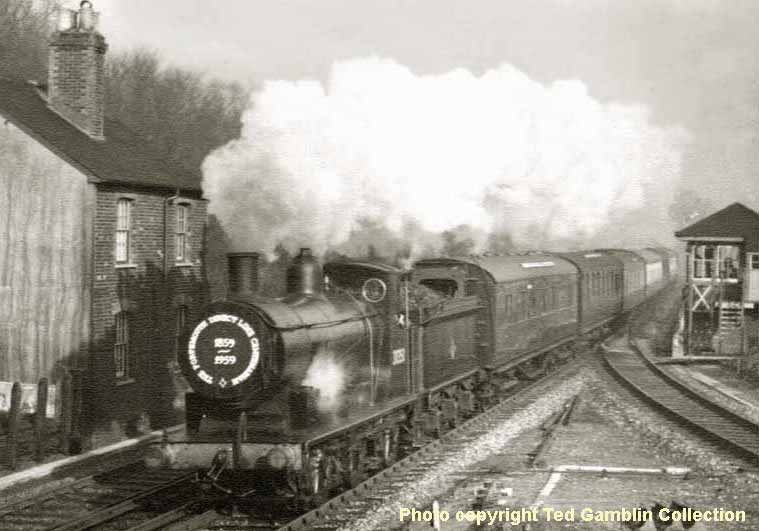
(Below) 395 Class 30567 has also been called upon to celebrate the event - The headboard is showing 'The Portsmouth Direct Line Centerarian'. Fifty of this class of locomotive of the seventy that were built were sent to the Middle East and elsewhere during the First World War and never returned. The last to survive, 30567 was withdrawn in September 1959 after 76 years in service and was scrapped. None have been preserved.
(Above-Below) Guildford Shed is a hive of activity as LSWR 415 Class 30582 trundles past. I'm not sure of the date or occasion but she would normally be seen working on the Lyme Regis branch line. Mystery solved thanks to Chris Knowles-Thomas, who writes - 'The photo of 0415 class 30582 at Guildford was taken on 19th March 1961. It worked a three coach special organised by the Railway Enthusiasts Club from Waterloo - Clapham Junction - Windsor - Woking - Guildford - Effingham Junction - Leatherhead - Wimbledon - Waterloo. It was booked to be at Guildford from 15.50 to 17.05 during which time (per the photo) 30582 obviously went to the shed for servicing. The 3-coach train was made up of pull-push set No 1 (ex-LSWR 6488 and ex-SECR 1066) plus another ex-SECR coachOnly one of this class remain and can be seen on the Bluebell Railway...' Thanks Chris...the concrete prefabricated building to the left of the photograph served two purposes; this end housed the turning gang and the other end was the cleaner's cabin where I first started work. (Below) The spectators have all gone as a Maunsell design L1 Class heads light engine towards Guildford station having just emerged from the tunnel. Withdrawal began in 1959 and the final locomotive was withdrawn in February 1962. None have been preserved.
(Above) A splendid shot of 700 Class 30325. The 70C plate on the smokebox denotes she was allocated to Guildford and I no doubt worked on her as a young fireman in 1962 before her appointment with the cutter's torch at Eastleigh later that year. Although it was rumoured that one of the class (they were nicknamed 'blackmotors') was to be consigned for posterity (30700) none of the class survived.
 (Above) C Class 31510 simmers gently in the reception road to Guildford MPD; Farnham Road bridge can be seen in the background. The covered arch under the bridge contained the railway's carpentry shop. A superb example of preservation of this type of locomotive - plus many other SR types - can be seen at the Bluebell Railway- click here to visit theBluebell Railway's website.
(Above) C Class 31510 simmers gently in the reception road to Guildford MPD; Farnham Road bridge can be seen in the background. The covered arch under the bridge contained the railway's carpentry shop. A superb example of preservation of this type of locomotive - plus many other SR types - can be seen at the Bluebell Railway- click here to visit theBluebell Railway's website.
(Left) I apologise unreservedly for wrongly attributing some photos taken by Norman Hamshere and Alan Hammond to Elsie Patrick, whose late husband, Reg Patrick worked as a fitter at Guildford shed and kept an album of old photographs, which includes this of himself posing for the camera in front of N15 'King Arthur' Class 30781 'Sir Aglovale'.
(Below) A cast aluminium nameplate measuring 64¼" long - 'County of Surrey' - from Class 73 No 73131 went under the hammer at a recent GCRA auction. The loco was delivered new to Stewarts Lane Depot as E6038 in July 1966, and named at Haslemere Station in March 1988. The plates were removed in October 1993. Withdrawn from Hither Green in September 2003, No 73131 was cut up by CF Booth at Rotherham in August the following year.


Geoff Burch's contact details can be found HERE.
Polite notice: All text and photographs are protected by copyright and reproduction is prohibited without the prior consent of the © owners. If you wish to discuss using the contents of this page the email address is below. Please note - this is not a 'clickable' mail-to link via Outlook Express. You will have to email manually.
dheycollection@ntlworld.com







